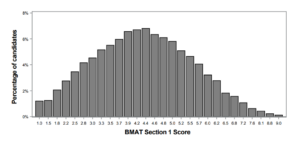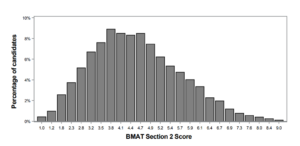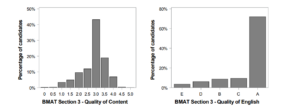How Is BMAT Scored?
BMAT scores are somewhat complicated, because your score is reported on a scale rather than as a sum of all the points you’ve achieved.
You can get a maximum of 32 points in Section 1 and a maximum of 27 in Section 2, with each correct answer earning you one point. However, your score will be reported on a scale between 1.0 and 9.0 and not by the number of points you’ve got.
These sections aren’t negatively marked, which means you won’t lose a point if you get a question wrong.
For Section 3, you’ll be given a score between 1 and 5 for the quality of content and then a grade A, C, or E for the quality of your English. The essay is marked by two examiners, so you get two scores which are then averaged to give your final score.
It’s explained in this video:
When Will I Get My BMAT Score?
Results for this year’s BMAT will be released on 24th November 2023.
Unlike the UCAT, you won’t know your BMAT score until after the UCAS deadline. This means that you have to take more of a gamble on which BMAT universities you apply to, because you’ll be choosing your Medical Schools without knowing how you performed in the BMAT.
What Is A Good BMAT Score?
A good BMAT score is usually 6.0 and above – with 7.0 and higher being very rare.
What Is An Average BMAT Score?
The average student can expect to get a BMAT score of around 5.0.
2023 BMAT Scores
Section 1 Scores

As you can see from the graph, around 25% of students scored between 5.0 and 6.0. Just under 10% of students scored higher than 6.0.
Section 2 Scores

In Section 2, just over 20% of students scored between 5.0 and 6.0. Just over 10% of students scored higher than 6.0. This shows a similar trend to Section 1.
Section 3 Scores

In Section 3, around 45% of students got a 3 for quality of content and almost 30% scored higher than a 3. For quality of English, around 70% got an A.
Previous BMAT Results
2022 BMAT
- Around 20% of students scored between 5.0 and 6.0 in Section 1. Just over 10% of students scored higher than 6.0.
- In Section 2, just over 20% of students scored between 5.0 and 6.0. Just over 10% of students scored higher than 6.0.
- In Section 3, just over 40% of students got a 3 for quality of content and around 20% scored higher than a 3. For quality of English, around 75% got an A.
2021 BMAT
- Just over 30% of students scored between 5.0 and 6.0 in Section 1, with around 5% scoring higher than 6.0.
- In Section 2, around 25% of students scored between 5.0 and 6.0, with around 5% scoring higher than 6.0.
- In Section 3, around 40% of students got a 3 for quality of content and just over 20% scored higher than a 3. For quality of English, nearly 80% scored an A.
How Are BMAT Scores Used?
Generally speaking, Medical Schools will use your BMAT score in conjunction with your GCSE grades and UCAS points to decide if you’ll be invited to interview.
Some universities place more emphasis on your BMAT score than others – but not all universities officially state how they use it, so it’s essential that you try to maximise your score in all sections!
We go into more detail on how BMAT universities use your score on this guide.
